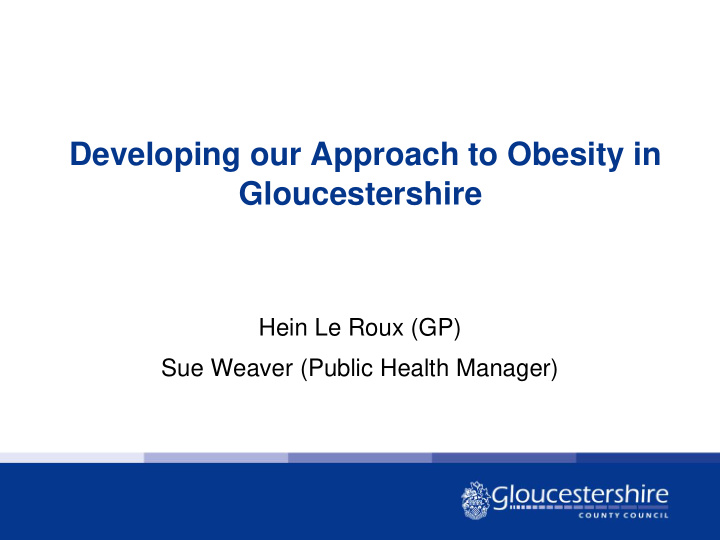



Developing our Approach to Obesity in Gloucestershire Hein Le Roux (GP) Sue Weaver (Public Health Manager)
Background • Reducing obesity is a Health and Wellbeing Board (HWBB) priority for improving health and wellbeing in Gloucestershire • HWBB has been awarded a place on the national Systems Leadership Programme • ‘Place-based approach’ requiring a step change across a whole system • Includes opportunities for leadership development training and an enabler (consultant with expertise in systems leadership) • Break the intergenerational cycle of obesity in areas of urban and rural deprivation.
Why is reducing obesity important? • ‘ Probably the most widespread threat to health and wellbeing in the country’ (DH, 2011) • Major risk factor for main causes of early death and ill-health: diabetes, heart disease, stroke, cancers (e.g. breast, colon), chronic respiratory disease • Dementia – emerging evidence of a link between obesity in middle age and the development of dementia > 65 years • Disability – obesity linked with four most prevalent disabling conditions: arthritis, back pain, mental health problems and learning disabilities
Why is reducing obesity important? • Obese children more likely to experience low self-esteem and depression and almost all have been teased or bullied • Child obesity is (weakly) associated with lower educational attainment; adult obesity affects employment chances • Obese employees take significantly more short- and long-term sickness absence (average four more days per year) • Obesity is a health inequalities issue affecting some of our most vulnerable individuals and communities • Strong association between obesity and deprivation – particularly among women and children
Obesity – what’s the cost? England • Wider economy - £20bn (lost productivity, sickness, social care, benefits) • NHS - £5bn per year Gloucestershire • ? Costs to wider economy • NHS Gloucestershire - estimated costs £149.1 million (NICE, 2010)
Government’s Ambition for Obesity • By 2020 we aim to see: - Sustained downward trend in levels of excess weight in children - Downward trend in the level of excess weight among adults - Narrow the gap in excess weight among children living in our most and our least deprived neighbourhoods.
The size of the issue • England now termed the ‘fat man of Europe’ – over a quarter of adults obese and 1 in 3 children overweight or obese by age ten • County obesity rates are similar to national averages - Adults: 24.7% (24.4% England) - 4-5 year olds 8.8% (9.4% England) - 10-11 year olds 17.9% (19.2% England) • Some signs of levels flattening off among 4-5 year olds • Based on current trends over half children will be overweight or obese by 2020.
‘Wicked Issue’
Obesogenic Settings and Environments
What works in reducing obesity? • Evidence of effectiveness for a range of interventions: - Increasing walk- and cycle-ability of environment to help people build physical activity into their daily lives - Controlling local availability of / exposure to ‘HFSS’ foods School based programmes, targeting children and parents e.g. ↓ - sugary drinks and screen time (KS2) - Targeted individual or family based support to reduce weight. • Gloucestershire have implemented a range of interventions across the life course under Healthy Weight Strategies (2001; 2007-17)
Why is a different approach needed? • Despite almost a decade of intervention - few signs of a decline in child obesity levels • By Year 10 > a quarter of children never do any physical activity outside school, only 16% eat ‘5 a day’, and > a third want information on how to lose weight (Gloucestershire OPS, 2012) • Delivery of ambitions require a ‘new approach’ (DH, 2011; NICE, 2012) • A system wide approach: integrated measures to tackle wider determinants, with some targeted support for those at greatest risk (NICE, 2012)
Learning from one example • EPODE (Europe) reduced excess weight among 7-9 year olds from 21.9% to 18.3% from 2000-2007 - Long-term approach (> 5 years) - ‘Everybody’s business’ – multi-sector including private / public partnerships - Focus on families (children as intermediaries) in small geographical areas - ‘Bottom-up approach’ - sustained community engagement - Local coordinators working on the ground to mobilise communities, create connections, support community-led innovation .
Next steps: What might this approach involve? • First step meeting with SLP Director 6 th August 2013 • Propose strategic partnership (Chair: Cllr Dorcas Binns) • Two pronged-approach: - System change involving policy, contracts, harnessing contribution of existing programmes to deliver coherent obesity prevention strategy for benefit of population as a whole - ‘Deep dive’ within relatively small communities at increased risk, based on sustained engagement , adopting a long term action learning approach.
Some food for thought • How do we ensure senior level sign up across key organisations and policy areas – including new partners e.g. business? • How do we make the most of collective resource – is this an opportunity for pooling budgets • How do we engage meaningfully with our communities? • How do we help to shift social norms?
Recommend
More recommend